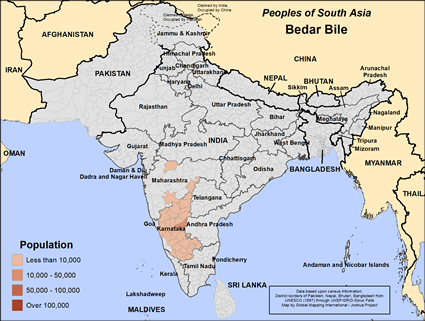Bedar Bile in India

Send Joshua Project a photo
of this people group. |

Map Source:
People Group data: Omid. Map geography: UNESCO / GMI. Map Design: Joshua Project
|
| People Name: | Bedar Bile |
| Country: | India |
| 10/40 Window: | Yes |
| Population: | 112,000 |
| World Population: | 112,000 |
| Primary Language: | Kannada |
| Primary Religion: | Hinduism |
| Christian Adherents: | 0.00 % |
| Evangelicals: | 0.00 % |
| Scripture: | Complete Bible |
| Ministry Resources: | Yes |
| Jesus Film: | Yes |
| Audio Recordings: | Yes |
| People Cluster: | South Asia Hindu - other |
| Affinity Bloc: | South Asian Peoples |
| Progress Level: |
|
Introduction / History
Bedar tradition states that Kannayya was a fowler and hunter and a devout worshipper of the god Shiva who was pleased with his devotion and appeared to him, granting two wishes. Kannayya prayed that his descendants would be true shots and their land would grow much corn with little labor or water.
The Bedars are a Dravidian tribe, meaning that they came from the original peoples of the Subcontinent. "Bedar" comes from the word "bed" or "bedaru" meaning a hunter. Hindus are known as Bedar and Muslims as Berad. They prefer to be called Naikwadi because they serve as village policemen or watchmen.
Where Are they Located?
The Bile Bedar people live only in the states of Karnataka and Maharasthra.
What Are Their Lives Like?
The Bedar language is a corruption of the Kannada and Marathi languages, though they also speak other languages depending on where they live. They have six social divisions. They work as servants, traders, messengers, police, and soldiers.
Men and women wear silver and gold jewelry. Some traditionally shave their heads, wear waist girdles, gold and silver bracelets and gold earrings. Women tie their hair in a loose knot, wear nose-rings, a gold necklace, and they have a hooped silver ornament on their heads.
At the age of four or five girls are tattooed on the forehead, corners of the eyes, temples, and forearms. Unmarried girls can be forced into prostitution. The girls are taken to a guru who brands them with a stamp, and then takes them to a temple where a necklace is tied around their neck in the name of the god, and they are now known as Basavi, a temple prostitute or entertainer.
The boy's parents initiate the marriage proposal. Child marriage is common, but the girl does not live with her husband until after puberty. Marriage cannot be within the same sub-division. They allow for widow remarriage and divorce. The Bedar have headmen to solve community disputes. They are non-vegetarian and drink alcohol.
What Are Their Beliefs?
Their Hindu images are usually made from silver, copper or brass. Bedar have faith in soothsaying, sorcery and astrology. Brahmins act as their priests and in some places Lingayat Mathpati's serve as their Hindu priests. Like other Hindus, they celebrate festivals such as Diwali, Dussera, Holi, etc. Hereditary gurus preside at these festivals.
What Are Their Needs?
The Bile Bedar people need to put all their faith in Jesus Christ, Lord of Lords.
Prayer Points
Pray for workers to go to the Bile Bedar people, and for their hearts to be ready to receive their Savior.
Pray for networks of believing families and fellowships that will throw the doors open for others to follow Jesus in their families and communities.
Pray for the Lord to bless the families among the Bile Bedar people with His presence and mercy.
Pray for Bible believing fellowships and churches among the Bile Bedar people.